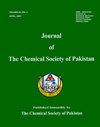To Explore the Effect of Injection Molding Processing Parameters on Crazing in Acrylic Polymers
IF 0.5
4区 化学
Q4 CHEMISTRY, MULTIDISCIPLINARY
Journal of the chemical society of pakistan
Pub Date : 2022-01-01
DOI:10.52568/001072/jcsp/44.04.2022
引用次数: 0
Abstract
Plastic manufacturing industry is the fastest growing industry as the demand for plastic products is exponentially growing worldwide. Poly (methyl methacrylate) (PMMA), also known as acrylic glass, is a transparent and rigid thermoplastic. PMMA is highly resistant to UV light. Weathering has an excellent light transmission and unlimited coloring options compared to other transparent plastic and has been used in wide applications such as architecture, automotive and transportation, lighting (LED lights), medical and healthcare, and furniture. Injection molding is the widely used plastic manufacturing process to produce plastic products for various applications. The quality of the plastic products depends on the injection molding parameters, viz. melting temperature, injection speed, and pressure, holding and cooling time, and holding pressure. Therefore, it is important to control injection molding parameters to reduce injection molding defects or parts. Hence, the main objective of this research is to optimize the injection molding parameters, including the amount of mold releasing agent, to avoid the crazing marks in PMMA which is a long-standing problem in the production of PMMA products or parts such as motorbike headlight lenses. Three different holding pressures (65, 75, and 85 kg/cm2) were varied against three different injection pressures (70, 80, and 90 kg/cm2). The injection speed (60 %), cooling time (4 s), and barrel zones temperature (185-205: 185-205: 190-210: 195-215) were kept constant not to disturb the production cycle, a constraint from the production industry. The minimum criteria required for the motorbike headlight lens selection was based on the LUX intensity test, density, and crazing demanded by the Japanese standard throughout this research. The optimized injection molding parameters and amount of mold releasing agent (Nabakem mold release R2) were 70 kg/cm2 (injection pressure), 65 kg/cm2 (holding pressure), and 1.18 g, respectively. The motorbike headlight lens produced with optimized injection molding parameters showed no crazing. In addition to the desired LUX intensity, density, and no crazing criteria, the motorbike headlight lens also showed improved impact properties and no substantial changes in mechanical properties when compared to virgin PMMA or literature. Hence, it is concluded that the optimized injection molding parameters (thermo-mechanical history) did not much affect the molecular weight and morphology of the PMMA.探讨注射成型工艺参数对丙烯酸树脂聚合物起纹的影响
塑料制造业是增长最快的行业,因为全球对塑料产品的需求呈指数级增长。聚甲基丙烯酸甲酯(PMMA),又称丙烯酸玻璃,是一种透明、刚性的热塑性塑料。PMMA对紫外线有很强的抵抗力。与其他透明塑料相比,耐候钢具有出色的透光性和无限的着色选择,并已广泛应用于建筑,汽车和交通,照明(LED灯),医疗保健和家具等领域。注射成型是一种广泛应用的塑料制造工艺,可生产各种用途的塑料制品。塑料制品的质量取决于注射成型参数,即熔化温度、注射速度和压力、保温和冷却时间以及保温压力。因此,控制注射成型参数以减少注射成型缺陷或零件是很重要的。因此,本研究的主要目的是优化注射成型参数,包括脱模剂的用量,以避免PMMA中的裂纹痕迹,这是PMMA产品或零件(如摩托车前灯镜头)生产中长期存在的问题。三种不同的保压压力(65、75和85 kg/cm2)对应三种不同的注射压力(70、80和90 kg/cm2)。注射速度(60%)、冷却时间(4 s)和桶区温度(185-205:185-205:190-210:195-215)保持不变,以免影响生产周期,这是生产行业的限制。摩托车前照灯镜头选择的最低标准是基于LUX强度测试、密度和日本标准在整个研究过程中所要求的光泽度。优化后的注射成型参数和脱模剂(Nabakem脱模R2)用量分别为70 kg/cm2(注射压力)、65 kg/cm2(保压压力)和1.18 g。采用优化的注射工艺生产的摩托车前照灯透镜无裂纹现象。除了期望的LUX强度、密度和无裂纹标准外,与原始PMMA或文献相比,摩托车前照灯透镜还显示出更好的冲击性能,并且机械性能没有实质性变化。由此可见,优化后的注射成型参数(热-力学历史)对PMMA的分子量和形貌影响不大。
本文章由计算机程序翻译,如有差异,请以英文原文为准。
求助全文
约1分钟内获得全文
求助全文
来源期刊
CiteScore
1.30
自引率
14.30%
发文量
41
审稿时长
3.4 months
期刊介绍:
This journal covers different research areas in the field of Chemistry. These include; Analytical Chemistry, Applied Chemistry, Biochemistry, Environmental Chemistry, Industrial Chemistry, Inorganic Chemistry, Organic Chemistry and Physical Chemistry. The journal publishes full length articles and Reviews from researchers in academia in addition to featuring comments. Chemical Research presents short, concise and critical articles offering easy-to-read overviews of basic research and applications in all areas of chemistry.

 求助内容:
求助内容: 应助结果提醒方式:
应助结果提醒方式:


